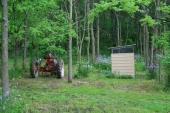50% peat moss
30% perlite
20% finely sifted
compost That's what I use and it works great. Problem is, peat moss is not a very sustainable resource, and if you don't live close to where it's harvested, it leaves a pretty big transportation footprint. I live in Manitoba Canada, where a very large portion of North Americas peat moss comes from, (my friends in Louisiana bought some peat the other day, and discovered it came from Manitoba) so the footprint isn't so bad for me.
Often when I am rooting cuttings, especially if they are suceptible to root/stem rot, I water them with a 2% bleach solution, so I can avoid nasty stuff like Serenade and the like. Don't do this if you use sand though. Works really well with my mix though. (It's the same mix I use to plant seeds it BTW, I just use a little more perlite and a little less compost for seeds)





